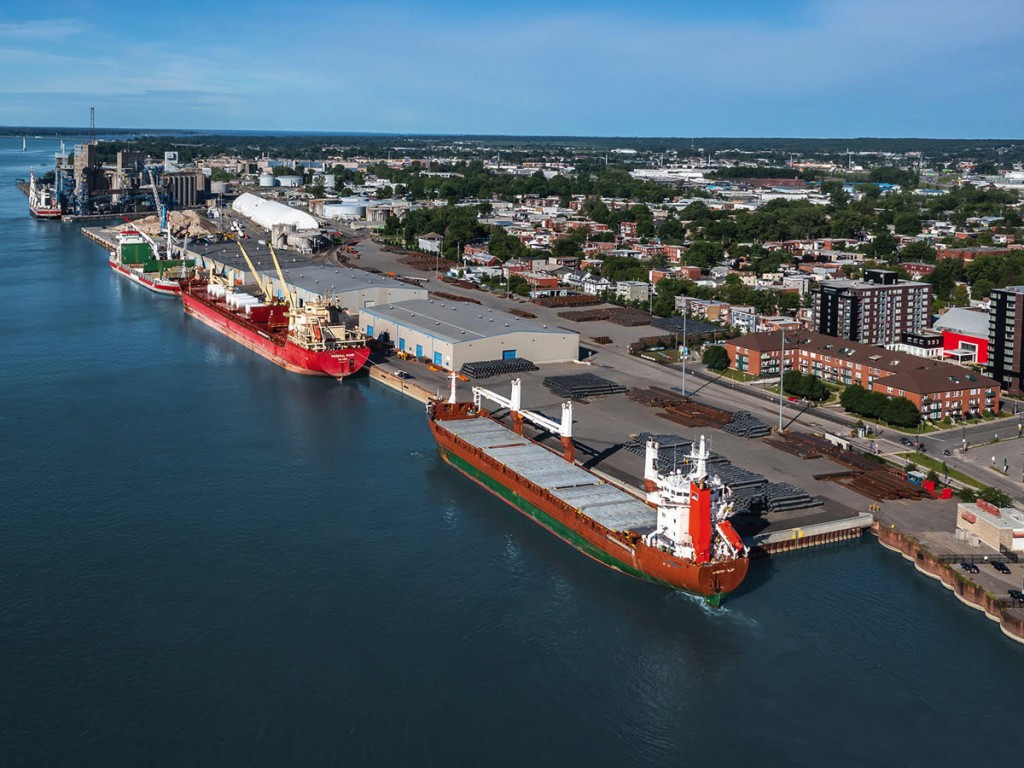As a continental gateway, the St. Lawrence River has been the scene of many developments in the past few years. These have ranged from the launching of a major multimodal/multipurpose terminal at Trois-Riviéres to the scrapping due to environmental issues of an ostensibly ill-conceived container project at the bulk-oriented Port of Quebec, and the steady progress of container capacity expansion at Montreal eyeing increased business with the Midwest and Asia.
But until earlier this summer, there has been a missing economies of scale structuring to meet ever-rising competitive and supply chain demands. Such a gap was filled, at least partly, when the above three St. Lawrence ports announced on June 14 the establishment of a working group to identify and facilitate the implementation of joint initiatives.

Strategic Port Alliances
This virtual strategic alliance could pave the way to an outright merger, though it could take several years to materialize, industry observers consider.
“The announcement by the ports of Quebec, Trois Rivieres and Montreal can be seen in the context of recent Transport Canada acceptance of mergers between port authorities, such as those around Vancouver, as well as an evolving international trend,” suggests Canadian transportation consultant Brian Slack.
“Perhaps the most notable is that of HAROPA, a merger between the French ports of Le Havre, Rouen and Paris, but other examples include Antwerp-Zeebrugge and Copenhagen-Malmo, the latter involving two ports in different countries,” Slack told AJOT in an interview.
“Co-operation, rationalisation, scale economies are some of the reasons put forward to justify such mergers,” Slack went on. “There is no clear evidence that mergers achieve these goals. It appears that success depends in part on local conditions and circumstances and a clear understanding of what are the specific goals.
“Proximity appears to be a factor. Like HAROPA, the proposed merger between Quebec, Trois Rivieres and Montreal involves ports geographically positioned along a major river. Whether this attribute can be exploited remains to be seen.”
From west to east over 160 miles of waterway, the ports of Montreal, Trois-Rivières and Québec have much in common. They are jointly responsible for the safe operation of traffic on a key section of a maritime corridor that connects the Atlantic Ocean to the industrial heartland of North America.

Lake Ontario Port Merger
Elsewhere in Canada, there was the merger in 2019 of the Lake Ontario ports of Hamilton and Oshawa into the Hamilton Oshawa Port Authority (HOPA). And on the West Coast, there was the amalgamation in 2008 of the Port of Vancouver, North Fraser Port Authority and Fraser River Port Authority. With then port chief executive Captain Gordon Houston playing a vital role, the creation of the Vancouver Fraser Port Authority has considerably strengthened Canada’s Pacific Gateway strategy.
The signing of a collaboration agreement between Montreal, Trois-Rivières and Québec on the St. Lawrence River has been motivated by strategic, environmental, and economic factors, a press release underlined.
The three ports combined annually handle approximately 72.4 million tons of general cargo, containers (almost all at Montreal), non-containerized general cargo, and solid and liquid bulk. The St. Lawrence is the entry and exit route for a multitude of goods, food and materials traded with the rest of the world.
“Global supply chains are being restructured. Shipping lines and import-export stakeholders are looking for the best routes at the best cost and want to accelerate the decarbonization of maritime transport. There are opportunities for our ports and for our economy,” stressed Martin Imbleau, President and CEO of the Montreal Port Authority, when the working group was unveiled.
“More than 80% of trade worldwide is done by ship and the St. Lawrence/Great Lakes axis is Canada’s most important trade corridor,” remarked Mario Girard, President and CEO of the Quebec Port Authority.

“What facilitates collaboration is complementarity,” opined Gaétan Boivin, President and CEO of the Trois-Rivières Port Authority. “The ports of Montréal, Québec and Trois-Rivières each have their own expertise and specific roles in the supply chain. Increasing our collaboration will create synergies that will benefit the customers we serve and the communities in which we operate.”
Claude Comtois, emeritus professor of geography at the University of Montreal who is a well-known expert on St. Lawrence and world logistics trends, feels the three-port agreement could lead to such developments as integrated management of the water column, an update of the pilotage conditions, joint marketing efforts, identification of new cargo owners, and greater energy transition of port activities.




